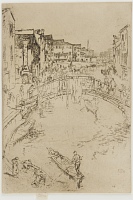Etchings Institutions search term: hughes kimber
The Bridge, Santa Marta | ||
| Number: | 201 | |
| Date: | 1879/1880 | |
| Medium: | etching and drypoint | |
| Size: | 298 x 202 mm | |
| Signed: | butterfly at lower right | |
| Inscribed: | no | |
| Set/Publication: | 'Second Venice Set', 1886 | |
| No. of States: | 9 | |
| Known impressions: | 47 | |
| Catalogues: | K.204; M.201; W.171 | |
| Impressions taken from this plate (47) | ||
TECHNIQUE
This copper plate was begun in pure etching, and the only drypoint in the first state is the indistinct butterfly signature. As Whistler developed the image, he added all the new detail in drypoint, and many of those lines wore out during printing. Some shading - like the verticals between the empty boat and the wall of the quay - was more emphatic, and those drypoint lines remain faintly visible on the last impressions printed, those taken from the cancelled copper plate. Whistler was evidently happy with his initial etched composition, because as fine drypoint work became worn, he continued to print the plate without renewing or replacing those lines. As Kennedy noted in his catalogue, this resulted in impressions of the final state resembling those of the first. 8 The similarity has led to misidentification of late impressions in a number of collections, where they have been catalogued as early ones.
8: Kennedy 1910 (cat. no. 204) p. 88.
PRINTING
Early impressions were mostly printed in black ink, on various papers including a thick pale buff 'antique' (pre-1800) laid paper ( ); laid paper with 'WW' countermark (
); laid paper with 'WW' countermark ( ,
,  ); light-weight 'antique' laid paper with a shield watermark (
); light-weight 'antique' laid paper with a shield watermark ( ); cream laid watermarked 'HDV' (
); cream laid watermarked 'HDV' ( ); and light-weight ivory laid with posthorn watermark (
); and light-weight ivory laid with posthorn watermark ( ). It was sometimes printed in brown ink, on 'modern' ivory laid paper, for instance (
). It was sometimes printed in brown ink, on 'modern' ivory laid paper, for instance ( ).
).
 ); laid paper with 'WW' countermark (
); laid paper with 'WW' countermark ( ,
,  ); light-weight 'antique' laid paper with a shield watermark (
); light-weight 'antique' laid paper with a shield watermark ( ); cream laid watermarked 'HDV' (
); cream laid watermarked 'HDV' ( ); and light-weight ivory laid with posthorn watermark (
); and light-weight ivory laid with posthorn watermark ( ). It was sometimes printed in brown ink, on 'modern' ivory laid paper, for instance (
). It was sometimes printed in brown ink, on 'modern' ivory laid paper, for instance ( ).
).When Whistler considered the plate completed - which was not until the final state - it was sent to Paris to be printed by Émile Frédéric Salmon (1840-1913). Salmon printed a clear, delicate impression in black ink on Asian laid paper ( ). Whistler did not apparently like Salmon's work and decided to print the edition for Messrs Dowdeswell and Thibaudeau himself.
). Whistler did not apparently like Salmon's work and decided to print the edition for Messrs Dowdeswell and Thibaudeau himself.
 ). Whistler did not apparently like Salmon's work and decided to print the edition for Messrs Dowdeswell and Thibaudeau himself.
). Whistler did not apparently like Salmon's work and decided to print the edition for Messrs Dowdeswell and Thibaudeau himself.There are numerous dockets, notes and receipts relating to this edition. Undated receipts include five, two and five impressions of The Bridge, respectively, but there are probably overlaps and duplications with other documents. 9 The principal list records that Dowdeswell received five impressions of The Bridge on 22 July 1886; one on 25 September 1886; and five on 5 January 1887. 10 Finally Whistler delivered 33 impressions (making a total of 44) plus one from the cancelled plate on 27 January 1887. 11
These later impressions were printed in dark brown ink on ivory Asian laid paper ( ,
,  ,
,  ); ivory laid paper (
); ivory laid paper ( ), buff wove, possibly Asian paper (
), buff wove, possibly Asian paper ( ); and, for a cancelled impression, a medium-weight ivory western paper, similar to an Asian paper (
); and, for a cancelled impression, a medium-weight ivory western paper, similar to an Asian paper ( ). One, from a set on off-white watermarked laid paper, was printed in black ink (
). One, from a set on off-white watermarked laid paper, was printed in black ink ( ).
).
 ,
,  ,
,  ); ivory laid paper (
); ivory laid paper ( ), buff wove, possibly Asian paper (
), buff wove, possibly Asian paper ( ); and, for a cancelled impression, a medium-weight ivory western paper, similar to an Asian paper (
); and, for a cancelled impression, a medium-weight ivory western paper, similar to an Asian paper ( ). One, from a set on off-white watermarked laid paper, was printed in black ink (
). One, from a set on off-white watermarked laid paper, was printed in black ink ( ).
).
